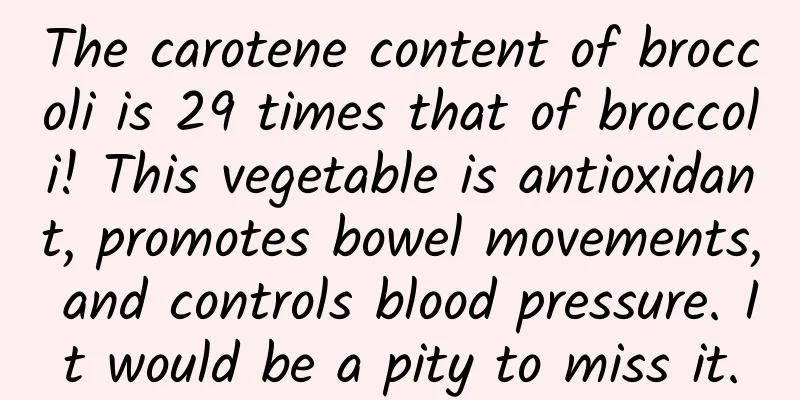The carotene content of broccoli is 29 times that of broccoli! This vegetable is antioxidant, promotes bowel movements, and controls blood pressure. It would be a pity to miss it.

|
When it comes to kale, many people only think of it in flower beds. It looks very attractive, with beautiful and varied leaf shapes and rich colors. The overall look is like a blooming peony, so it is also called "leaf peony". In fact, kale is not only an ornamental plant, but also a very nutritious vegetable. It’s just that it tastes bad, so few people eat it. In this article, we will talk about kale, where its nutritional value lies, and how to eat it to make it more palatable. Image source: Photographed by Zhong Yanping What is kale? What are the nutritional values? Kale belongs to the cruciferous plant, native to the Mediterranean coast. It was planted in Europe more than 4,000 years ago, and my country only began to introduce it for cultivation in the 1990s. With its attractive and cold-resistant characteristics, it has become the protagonist in the flower bed and has great ornamental value. It can grow normally in an environment of 5℃~30℃, and can also tolerate short-term low temperatures of -10℃~-15℃. The leaf edges are yellow-green, dark green, emerald green, gray-green, purple-red, red, pink, etc., and the leaf surface is light yellow, green, etc. The color of its central leaves is particularly rich, including purple, rose red, pink, dark red, yellow, light yellow, pure white, flesh color, etc., and there are also variegated varieties. It is so colorful and graceful that it is really suitable as an ornamental plant. And if it is eaten as a vegetable, it is also very good! Because compared with most common vegetables, it is rich in dietary fiber, vitamin B2, vitamin C, calcium, potassium, magnesium and other nutrients. 1 Dietary fiber Kale is rich in dietary fiber, which makes people feel a little chewy. Its total dietary fiber content is as high as 4.1 grams per 100 grams, and its insoluble dietary fiber content is 3.2 grams per 100 grams, which is more than 3 times that of cabbage. Increasing the intake of kale in daily life can help us supplement more dietary fiber, which can not only enhance the sense of fullness, but also promote gastrointestinal motility and protect intestinal health. 2 Vitamin C The vitamin C content of kale is 63 mg/100 g, which is higher than that of broccoli, which is also a cruciferous vegetable, and 1.7 times that of Chinese cabbage. Other literature shows that its vitamin C content is as high as 150~200 mg/100 g. Although there will be a loss after cooking, the high content is still very helpful in supplementing vitamin C. 3 Vitamin K The vitamin K content of kale is 390 micrograms per 100 grams, which is 8.5 times that of Chinese cabbage. Vitamin K can promote calcium deposition in bones and promote bone health. 4 carotene Kale also has a high carotene content of 4368 micrograms per 100 grams, which is higher than carrots (4107 micrograms per 100 grams) and nearly 29 times that of broccoli. Among them, β-carotene can also be converted into vitamin A in the body, which helps relieve eye fatigue and prevent night blindness. 5 Potassium and magnesium The potassium content of kale is 395 mg/100 g, which is 1.5 times the potassium content of bananas we often eat. The rich mineral potassium helps stabilize blood pressure and is very suitable for people who need to control blood pressure. The magnesium content is 53 mg/100 g, which is higher than cabbage, broccoli, Chinese cabbage, etc. Adequate magnesium intake is also helpful for maintaining healthy blood pressure and is also necessary for maintaining bone health. 6 calcium The calcium content of kale is 66 mg/100 g. Even though milk is the main source of calcium in our diet, calcium in vegetables is also very important. Although the calcium content of kale is not as high as that of rapeseed and Chinese cabbage, it is higher than that of Chinese cabbage, cabbage, celery, broccoli, lettuce, etc. Phytochemicals are also great The reason why kale has beautiful colors has a lot to do with its anthocyanin content, which directly affects the color of plant organs. Figure: Two colors of kale (from reference 5) Anthocyanin is an antioxidant ingredient with multiple health benefits such as anti-inflammatory, anti-tumor, anti-aging, helping to regulate blood sugar and blood lipids, and preventing cardiovascular diseases. In addition, kale also contains glucosinolates, which are ingredients found in almost all cruciferous vegetables. They give food a unique flavor and are also beneficial to health. Studies have shown that glucosinolates have anti-cancer, antioxidant, anti-inflammatory, wound healing, antibacterial, and relieving symptoms of Alzheimer's disease and chronic diseases. However, glucosinolates have both advantages and disadvantages. They can also have anti-nutritional effects on the human body and inhibit the thyroid gland's absorption of iodine. This has little impact on healthy people, and normal daily consumption of cruciferous vegetables will hardly have a negative impact on the thyroid gland. However, patients with thyroid diseases who do not have sufficient iodine intake should be cautious when eating them and should not eat them in large quantities. So kale is a pretty good vegetable. Do you want to eat it? Wait a minute, everyone says kale is terrible. It's true! Why is kale not tasty? How to solve the taste problem? Kale not only tastes rough, but also a bit bitter. The rough taste is due to its rich dietary fiber, while the bitterness is related to some special ingredients it contains. Cabbage plants contain two types of defense chemicals, including flavor precursors and enzymes that act on these substances to form flavors. Once the plant is invaded, such as when an animal bites and destroys the plant cells, these two types of substances will meet and mix together, and the enzymes will trigger the flavor precursors to produce bitter, pungent and other strong-tasting compounds. Glucosinolate is one of the defensive precursors of the cabbage family. Glucosinolate and its hydrolysis products have a certain bitter and spicy flavor. In addition, glucosinolates decompose when heated, so blanching before eating can reduce the bitter and spicy taste. If kale can be fermented into kimchi or pickles, the bitter and spicy taste can also be significantly reduced. Is kale powder worth buying? There is some kale powder on the market that is very popular now, and many businesses claim that it is not only nutritious, but also can help lose weight and prevent constipation. If you want to eat it, it is recommended to choose kale powder processed by freeze-drying process, which will retain better nutrition. It is especially recommended for people who usually eat very few vegetables in their three meals. Because most of these people do not consume enough dietary fiber, eating some kale powder can help us supplement dietary fiber and help prevent constipation. In general, eating kale powder to supplement some nutrition is OK, but don't expect to lose weight by eating it, as a single food does not have this effect. Another thing to note is that the glucosinolate content in freeze-dried kale powder may be higher than that in fresh vegetables. If you have thyroid-related diseases, it is recommended to consult a doctor before making a decision based on your own situation. Summarize Kale is not only good-looking, but also edible! It is a good supplement for dietary fiber, vitamin C, beta-carotene, vitamin K, potassium, magnesium and antioxidants. It is really good to eat it occasionally. However, it is more important to diversify your diet! References [1] Zhao Huayuan, Li Yingying. Ornamental characteristics and gardening applications of kale[J]. Heilongjiang Agricultural Science, 2011(02):96-97. [2]https://fdc.nal.usda.gov/fdc-app.html#/food-details/168421/nutrients [3] Yang Yuexin. Chinese Food Composition Table 6th Edition Volume 1[M]. Peking University Medical Press, 2018 [4] Tao Xiaoqi, Chen Pei, Li Yuanzhi, et al. Research progress on the nutritional value and processing of kale [C]//Guangdong Food Society, Sinopharm Reed Exhibitions Co., Ltd. "Healthy China 2030·Safety and Innovation of Healthy Food" Academic Seminar and Proceedings of the 2018 Guangdong Food Society Annual Conference. School of Food Science and Technology, South China Agricultural University; Yangjiang Smart Agriculture Technology Development Co., Ltd., 2018: 5. [5] Wang Yushu, Zhao Shuang, Zhang Lin, Cui Jianying, Wang Ziwei, Qu Meizhuoma, Gao Yansong, Xin Xifeng. Localization and content determination of anthocyanins in kale[J]. Journal of China Agricultural University, 2020, 25(11): 45-53. [6] Tian Yan, Deng Fangming, Qing Zhixing, Zhao Lingyan, Peng Pei. Research progress on the structure and function of glucosinolates in cruciferous plants[J]. Food Science, 2020, 41(01): 292-303. [7] Harold Mackey, author. Translated by Cai Chengzhi. Food and Cooking. Vegetables, Fruits, Spices, and Grains. Beijing Fine Arts Photography Publishing House. August 2013. Planning and production Author: Xue Qingxin, registered nutritionist Review | Ruan Guangfeng, Deputy Director of Kexin Food and Health Information Exchange Center Planning丨Zhong Yanping Editor: Zhong Yanping Proofread by Xu Lailinlin |
<<: This rare water bird can even bring its own "spoon" to eat?
>>: Can we keep the “teeth” like the “elephant”?
Recommend
Are you still worried about the advertising materials for Moments? Here is a complete design specification!
1. Copywriting Copywriting is an important part o...
Case Analysis | WeChat Reading VS Douban Reading, social ecology or original platform?
As a heavy user of reading apps, the author succe...
How to build your personal blog Android App from scratch?
Overview I recently implemented my first personal...
Mijia Fresh Air Fan: Removes indoor formaldehyde and carbon dioxide pollution in 30 minutes, with air purification standards exceeding those of five-star hotels
Air, sunlight and water are the three fundamental...
How would you set up an account for multi-region advertising?
Account structure is both our tool to control tra...
618 Advertising tips for the education and training industry!
With the arrival of the 618 mid-year sale, educat...
Insights: True self-discipline is to be responsible for your own life
Famous Artists Gallery | Chen Banding, also known...
Anne's Writing Class 2, valued at RMB 899
Anne's Writing Class 2, valued at RMB 899 The...
Beware! Smart bracelets have become "digital handcuffs", and many people are forced to do this...
Health apps don’t make us healthier, they may eve...
Check out the three common explosive points of “screen-sweeping” marketing!
The author reviewed and sorted out nine marketing...
What to do if your Huawei phone consumes battery quickly after upgrading to Hongmeng? Try this method, many people say it works
Some netizens have reported that their phones con...
How to escape from a fire? No equipment is needed!
As the saying goes, "fire and water are merc...
Nuclear power heating is being used in many places in China. Is it safe? Will it be widely used in the future?
In Shandong, Liaoning, Zhejiang and other places,...
Developers can now submit Apple Watch apps
Apple announced on Tuesday that all registered de...









